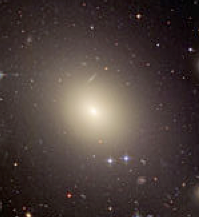Ellipticals
Roughly 4% of all galaxies are classified as ellipticals (as in Figure 1). These are actually ellipsoids (i.e., 3D ellipses), and are believed to get their shape from two galaxies merging. How exactly this happens has not been identified. Ellipticals do not have bimodal cores, and the density drops off smoothly from the center, producing an indistinct boundary. The motion of stars within the galaxy appears to be more radial than rotational, though the rotational component appears to vary with the aspect ratio (i.e., major axis over minor axis). Hence nearly spherical galaxies have no detectable average rotation, and the stars move in random directions. The greater the aspect ratio, the more consistently all of the stars rotate in the same direction.The stars in elliptical galaxies appear to be much older than in spiral galaxies, implying that the galaxies are stable in this configuration. Nevertheless, ellipticals (such as NGC 4486 and NGC 383) sometimes shoot out relativistic jets from their active galactic nuclei, and ellipticals are the only galaxies that emit bipolar radio source jets. When active, these jets clearly reveal powerful energy sources in the galactic nuclei, and this can only be evidence of matter converging on the center. The implosion will reforge old stars into new ones.











